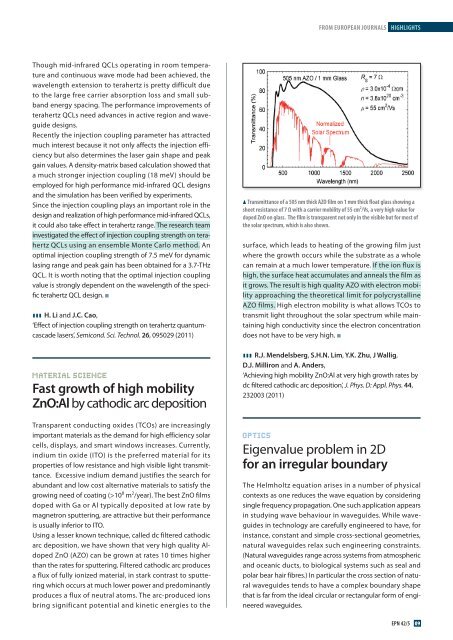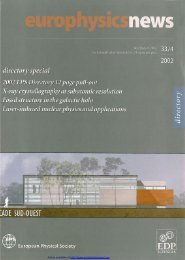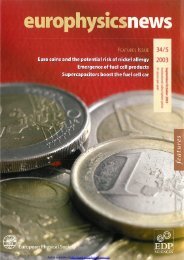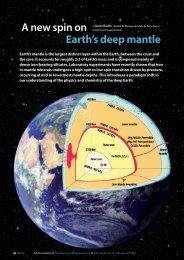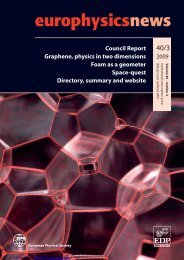PDF (11.37 MB) - Europhysics News
PDF (11.37 MB) - Europhysics News
PDF (11.37 MB) - Europhysics News
Create successful ePaper yourself
Turn your PDF publications into a flip-book with our unique Google optimized e-Paper software.
Though mid-infrared QCLs operating in room temperature<br />
and continuous wave mode had been achieved, the<br />
wavelength extension to terahertz is pretty difficult due<br />
to the large free carrier absorption loss and small subband<br />
energy spacing. The performance improvements of<br />
terahertz QCLs need advances in active region and waveguide<br />
designs.<br />
Recently the injection coupling parameter has attracted<br />
much interest because it not only affects the injection efficiency<br />
but also determines the laser gain shape and peak<br />
gain values. A density-matrix based calculation showed that<br />
a much stronger injection coupling (18 meV) should be<br />
employed for high performance mid-infrared QCL designs<br />
and the simulation has been verified by experiments.<br />
Since the injection coupling plays an important role in the<br />
design and realization of high performance mid-infrared QCLs,<br />
it could also take effect in terahertz range. The research team<br />
investigated the effect of injection coupling strength on terahertz<br />
QCLs using an ensemble Monte Carlo method. An<br />
optimal injection coupling strength of 7.5 meV for dynamic<br />
lasing range and peak gain has been obtained for a 3.7-THz<br />
QCL. It is worth noting that the optimal injection coupling<br />
value is strongly dependent on the wavelength of the specific<br />
terahertz QCL design. ■<br />
III h. li and J.c. cao,<br />
‘Effect of injection coupling strength on terahertz quantumcascade<br />
lasers’, Semicond. Sci. Technol. 26, 095029 (2011)<br />
MATERIAL SCIENCE<br />
fast growth of high mobility<br />
zno:al by cathodic arc deposition<br />
Transparent conducting oxides (TCOs) are increasingly<br />
important materials as the demand for high efficiency solar<br />
cells, displays, and smart windows increases. Currently,<br />
indium tin oxide (ITO) is the preferred material for its<br />
properties of low resistance and high visible light transmittance.<br />
Excessive indium demand justifies the search for<br />
abundant and low cost alternative materials to satisfy the<br />
growing need of coating (>10 8 m 2 /year). The best ZnO films<br />
doped with Ga or Al typically deposited at low rate by<br />
magnetron sputtering, are attractive but their performance<br />
is usually inferior to ITO.<br />
Using a lesser known technique, called dc filtered cathodic<br />
arc deposition, we have shown that very high quality Aldoped<br />
ZnO (AZO) can be grown at rates 10 times higher<br />
than the rates for sputtering. Filtered cathodic arc produces<br />
a flux of fully ionized material, in stark contrast to sputtering<br />
which occurs at much lower power and predominantly<br />
produces a flux of neutral atoms. The arc-produced ions<br />
bring significant potential and kinetic energies to the<br />
from euroPean JournalS HigHligHTS<br />
� Transmittance of a 505 nm thick aZo film on 1 mm thick float glass showing a<br />
sheet resistance of 7 Ω with a carrier mobility of 55 cm 2 /vs, a very high value for<br />
doped Zno on glass. The film is transparent not only in the visible but for most of<br />
the solar spectrum, which is also shown.<br />
surface, which leads to heating of the growing film just<br />
where the growth occurs while the substrate as a whole<br />
can remain at a much lower temperature. If the ion flux is<br />
high, the surface heat accumulates and anneals the film as<br />
it grows. The result is high quality AZO with electron mobility<br />
approaching the theoretical limit for polycrystalline<br />
AZO films. High electron mobility is what allows TCOs to<br />
transmit light throughout the solar spectrum while maintaining<br />
high conductivity since the electron concentration<br />
does not have to be very high. ■<br />
III r.J. mendelsberg, s.h.n. lim, y.K. zhu, J Wallig,<br />
D.J. milliron and a. anders,<br />
‘Achieving high mobility ZnO:Al at very high growth rates by<br />
dc filtered cathodic arc deposition’, J. Phys. D: Appl. Phys. 44,<br />
232003 (2011)<br />
OPTICS<br />
Eigenvalue problem in 2D<br />
for an irregular boundary<br />
The Helmholtz equation arises in a number of physical<br />
contexts as one reduces the wave equation by considering<br />
single frequency propagation. One such application appears<br />
in studying wave behaviour in waveguides. While waveguides<br />
in technology are carefully engineered to have, for<br />
instance, constant and simple cross-sectional geometries,<br />
natural waveguides relax such engineering constraints.<br />
(Natural waveguides range across systems from atmospheric<br />
and oceanic ducts, to biological systems such as seal and<br />
polar bear hair fibres.) In particular the cross section of natural<br />
waveguides tends to have a complex boundary shape<br />
that is far from the ideal circular or rectangular form of engineered<br />
waveguides.<br />
EPN 42/5 09


